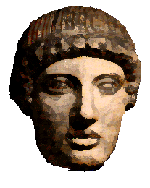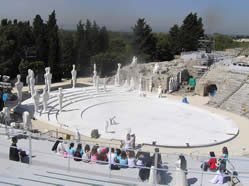Drama Reviews
- Sophocles Electra. A new version by Nick Payne - Gate Theatre, Notting Hill London, 18 April 2011
- Agamemnon by Aeschylus (in Greek) - Playhouse, Oxford, 2008
- Burial at Thebes [Antigone] translated by Seamus Heaney - Playhouse, Oxford 2008
- Seven Against Thebes by Aeschylus - Teatro Greco Syracuse, Sicily May 2005
- Bacchae by Euripides - Teatro Greco Palazzolo Acreide, Sicily 2005
- Cyclops by Euripides - Teatro Greco Palazzolo Acreide, Sicily 2005
- Lysistrata by Aristophanes - Teatro Greco Palazzolo Acreide, Sicily 2005
- Antigone by Sophocles - Teatro Greco Syracuse, Sicily May 2005
Antigone di Sofocle (Sophocles' Antigone)
Directed by Irene Papas, performed in Italian.
The theatre (left)on the morning before the performance: some impression of the heat (in late May) can be gained: the performance began at 6.30 pm, by which time it was a little cooler, and there was a pleasant breeze, blowing up the dust at the front (appropriate for the Guard's second appearance!). But unlike the original performance, which I like to suppose started in the gloom of early morning and used the sunlight appearing over Mount Hymettus as the chorus entered, this began in brightness and moved towards the dark.
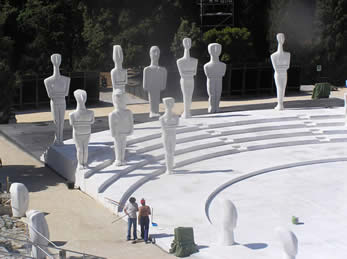 The set consisted of a white circle with shallow steps upstage, on which stood an assortment of gigantic naked figures, male and female. Immediately the question arose: why on earth? The inspiration was obviously intended to be the mysterious Cycladic figurines, which can be seen in the NAM in Athens or in the British Museum. But (a) the originals are tiny - images that ask to be felt or held in the hand and (b) the Cycladic originals were as remote from Sophocles as Sophocles is from us (about 2500 years in each case): except that we know of them and Sophocles didn't! So a piece of design for design's sake then? Having said that - if one knew nothing of Cycladic art at all, the giant figures were curiously impressive - faceless, remote: divinities that would seem oblivious to human action (is this what's wanted though? Are gods in the drama oblivious to the human tragedy unfolding beneath them? Perhaps this production's gods were not quite as bizarre as in the so styled "Oedipus trilogy" performed at the National Theatre in London a decade or so ago, where Apollo and Dionysus (why them?) were present throughout, symbolised by two huge balloons suspended over the auditorium!
The set consisted of a white circle with shallow steps upstage, on which stood an assortment of gigantic naked figures, male and female. Immediately the question arose: why on earth? The inspiration was obviously intended to be the mysterious Cycladic figurines, which can be seen in the NAM in Athens or in the British Museum. But (a) the originals are tiny - images that ask to be felt or held in the hand and (b) the Cycladic originals were as remote from Sophocles as Sophocles is from us (about 2500 years in each case): except that we know of them and Sophocles didn't! So a piece of design for design's sake then? Having said that - if one knew nothing of Cycladic art at all, the giant figures were curiously impressive - faceless, remote: divinities that would seem oblivious to human action (is this what's wanted though? Are gods in the drama oblivious to the human tragedy unfolding beneath them? Perhaps this production's gods were not quite as bizarre as in the so styled "Oedipus trilogy" performed at the National Theatre in London a decade or so ago, where Apollo and Dionysus (why them?) were present throughout, symbolised by two huge balloons suspended over the auditorium!
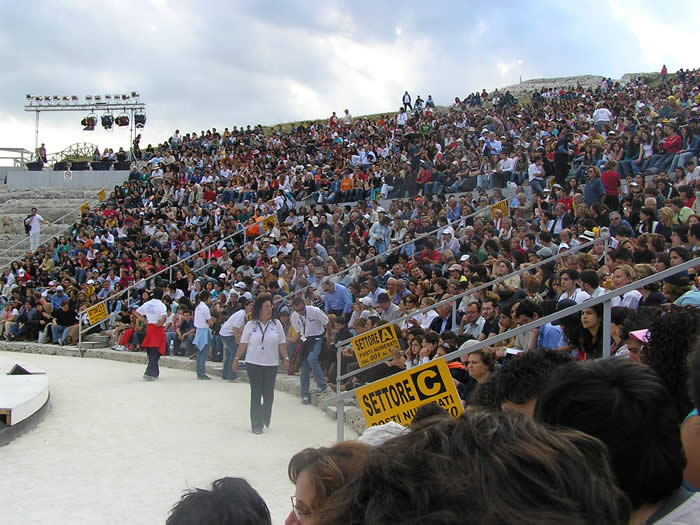
The cavea was full from at least 5pm, mainly with large student parties happily texting, ipodding and playing computer games. I arrived at about 5.30 and managed to squeeze in at the end of the second row: more conventional theatregoers - arriving after 6pm properly dressed up - found it difficult to find places without climbing to the very top, where many people were already sitting on the grass. I was glad of my hired cushion, as the marble of my seat had eroded more than somewhat. But it was a fine sight to see a Greek theatre full and buzzing with conversation.
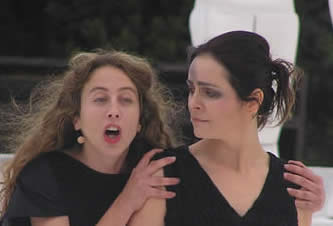 The play opened thrillingly with an ear-shattering scream (the production had not trusted the ancient acoustics - all performers wore microphones: this encouraged the audience to chat assuming they could not be heard. But a background noise of screaming low-flying swifts - or cooing pigeons as in the Globe theatre in London - would have been more acceptable. It spoiled the intimacy, and forced all actors to up their volume). Antigone and Ismene sprinted across the huge orchestra cowering as bombs were heard to land around them, but there was nowhere to hide: a city under heavy bombardment was suggested very simply with just sound and movement. The actors in black were starkly silhouetted against the white background, fading to a bloodstained pink as the sunset progressed from our right (orientation of this theatre is the same as the Theatre of Dionysus in Athens). The visual impression - two tiny figures alone in the great empty circle beneath the towering divinities - underlined their isolation and powerlessness.
The play opened thrillingly with an ear-shattering scream (the production had not trusted the ancient acoustics - all performers wore microphones: this encouraged the audience to chat assuming they could not be heard. But a background noise of screaming low-flying swifts - or cooing pigeons as in the Globe theatre in London - would have been more acceptable. It spoiled the intimacy, and forced all actors to up their volume). Antigone and Ismene sprinted across the huge orchestra cowering as bombs were heard to land around them, but there was nowhere to hide: a city under heavy bombardment was suggested very simply with just sound and movement. The actors in black were starkly silhouetted against the white background, fading to a bloodstained pink as the sunset progressed from our right (orientation of this theatre is the same as the Theatre of Dionysus in Athens). The visual impression - two tiny figures alone in the great empty circle beneath the towering divinities - underlined their isolation and powerlessness.
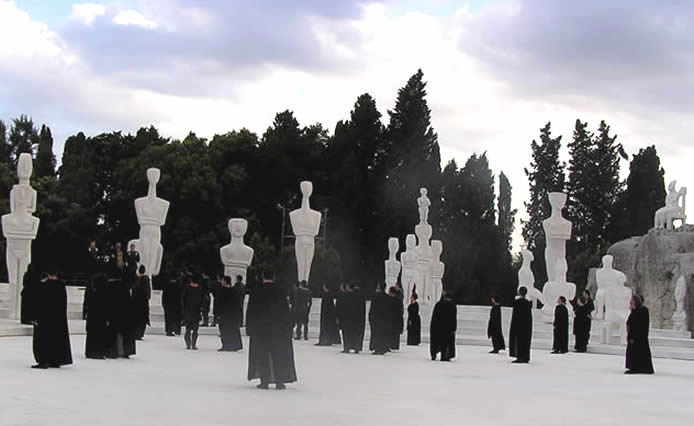
The chorus, as seems inevitable in modern productions, were treated as individuals: although the sheer weight of numbers filling the arena added considerably to the spectacle: but a specific chorus role could not be established with them occupying the same space as the actors: so the overall effect was alienating rather than assisting the audience to feel included in the drama.
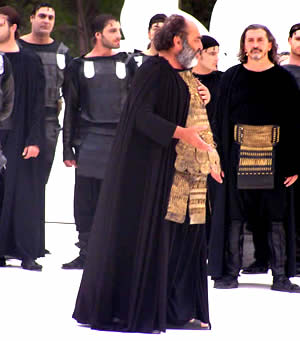 Then came Creon - a virtuoso performance, from an actor who seemed to to believe he was a wicked operatic villain rather than a character trying to reconcile impossible conflicts between family and politics. He ranted from the outset - and had nowhere to go except further towards chronic pharyngitis: thanks to the amplification, he couldn't even get louder! The out of control, over the top grotesque self-indulgence of his performance was symbolised by his treatment of the phylax, whom he punched, pushed and kicked. I've seen productions where the Guard is (mistakenly I believe) treated as a comic character: this is the first one where Creon seemed to have strayed from Plautus' Miles Gloriosus. The audience applauded when he made the decision to bury the body and release Antigone - but as they had applauded his other set speeches, I assumed that they were treating it as opera, and rewarding him for what they perceived as the "emotion" he was putting into his performance. But to me the crucial scene of the tragedy is the confrontation between Creon and his son Haemon - this was never going to be anything other than a pointless shouting match: there seemed to be no logical or dramatic motivation for Haemon to bother attempting to persuade this cantankerous old buffoon. And yet this play is all about persuasion! (see my page on Creon)
Then came Creon - a virtuoso performance, from an actor who seemed to to believe he was a wicked operatic villain rather than a character trying to reconcile impossible conflicts between family and politics. He ranted from the outset - and had nowhere to go except further towards chronic pharyngitis: thanks to the amplification, he couldn't even get louder! The out of control, over the top grotesque self-indulgence of his performance was symbolised by his treatment of the phylax, whom he punched, pushed and kicked. I've seen productions where the Guard is (mistakenly I believe) treated as a comic character: this is the first one where Creon seemed to have strayed from Plautus' Miles Gloriosus. The audience applauded when he made the decision to bury the body and release Antigone - but as they had applauded his other set speeches, I assumed that they were treating it as opera, and rewarding him for what they perceived as the "emotion" he was putting into his performance. But to me the crucial scene of the tragedy is the confrontation between Creon and his son Haemon - this was never going to be anything other than a pointless shouting match: there seemed to be no logical or dramatic motivation for Haemon to bother attempting to persuade this cantankerous old buffoon. And yet this play is all about persuasion! (see my page on Creon)
Visually the production was a brilliant success. The huge chorus helped fill the enormous orchestra - there must have been 50 - 60, including the four leaders, guards, men women and singers. Antigone changed into a flowing white robe as the bride of death: the only white costume against the sea of black, apart from Eurydice, regal in scarlet - the only colour on the stage at any time. I'd quarrel, though, with having her come on "before her time" with Ismene to place a bridal head-dress on Antigone before she is taken away to her death-prison: surely the dramatic effect of having her appear to listen to the messenger's speech about her son's death is then lost: we had never considered before that Creon even had a wife. Tiresias went into a trance and delivered his prognostications from a supine position (not quite sure whether this was brilliantly effective or another moment in danger of descending into comedy: on balance I think it undermined his credibility - he is emphatically not in a trance when he foretells Creon's future!).
To conclude: Greek tragedy is not opera (although Opera was invented to recreate Greek Tragedy, of course): true, it similarly uses every means possible to engage the emotions - but its speeches are not just a series of arias to be applauded. Someone once defined etymology as a science where the vowels count for nothing and the consonants for very little: this was a production where, of Aristotle's two staples, plot counted for nothing and character for very little.

